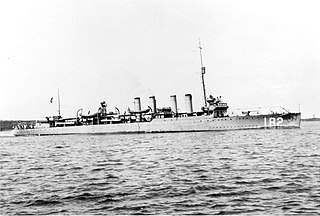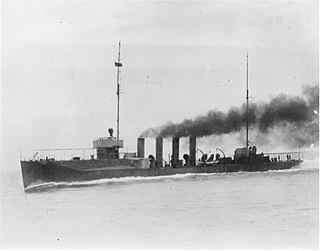
Point Judith is a village and a small cape, on the coast of Narragansett, Rhode Island, on the western side of Narragansett Bay where it opens out onto Rhode Island Sound. It is the location for the year-round ferry service that connects Block Island to the mainland and contains the fishing hamlet of Galilee, Rhode Island.

German submarine U-853 was a Type IXC/40 U-boat of Nazi Germany's Kriegsmarine during World War II. Her keel was laid down on 21 August 1942 by DeSchiMAG AG Weser of Bremen. She was commissioned on 25 June 1943 with Kapitänleutnant Helmut Sommer in command. U-853 saw action during the Battle of the Atlantic in World War II. She conducted three patrols, sinking two ships totalling 5,353 GRT and 430 tons.

The first USS Twiggs (DD–127) was a Wickes-class destroyer in the United States Navy during World War I. She was named for Major Levi Twiggs. She was later transferred to the Royal Navy, as HMS Leamington and to the Soviet Navy as Zhguchy, before returning to Britain to star in the film The Gift Horse, which depicts the St. Nazaire Raid.

The first USS Thomas (DD–182) was a Wickes-class destroyer of the United States Navy that entered service just after World War I.

The O'Brien class of destroyers was a class of six ships designed by and built for the United States Navy shortly before the United States entered World War I. The O'Brien class was the third of five classes of destroyers that were known as the "thousand tonners", because they were the first U.S. destroyers over 1,000 long tons (1,016 t) displacement.

USS Satterlee (DD-190) was a Clemson-class destroyer in the United States Navy, entering service in 1919. After brief service until 1922, the ship was placed in reserve. The ship was reactivated for World War II before being transferred to the Royal Navy in 1940. Renamed HMS Belmont, the destroyer was used as a convoy escort in the Battle of the Atlantic where she was torpedoed and sunk on 31 January 1942.

USS Borie (DD-215) was a Clemson-class destroyer in the United States Navy during World War II. She was the first ship named for Ulysses S. Grant's Secretary of the Navy, Adolph E. Borie. She served in the Black Sea, the Asiatic Fleet and the Caribbean between the wars, and in the Battle of the Atlantic, the long campaign to protect Allied shipping from German U-boats during World War II. As part of the antisubmarine Hunter-killer Group unit Task Group 21.14, the crew earned a Presidential Unit Citation for its "extraordinary performance." Borie also earned distinction in her final battle with U-405 in November 1943, exchanging small arms fire with and ramming the surfaced U-boat, although she was crippled during the engagement and thereafter scuttled by friendly ships.

USS Bulmer (DD-222/AG-86) was a Clemson-class destroyer in the United States Navy during World War II. It was the last warship of the Asiatic Fleet in USN commission.

USS Ericsson (DD-440), a Gleaves-class destroyer, was the third ship of the United States Navy to be named after John Ericsson, who is best known for devising and building the Civil War ironclad USS Monitor.

USS Rich (DE-695) was a Buckley-class destroyer escort, the first United States Navy ship named in honor of Lieutenant (j.g.) Ralph M. Rich (1916–1942) who was awarded the Navy Cross for his leadership as a fighter pilot off Enterprise during the Battle of Midway.

USS Hobson (DD-464/DMS-26), a Gleaves-class destroyer, was the only ship of the United States Navy to be named for Richmond Pearson Hobson, who was awarded the Medal of Honor for actions during the Spanish–American War. He would later in his career attain the rank of rear admiral and go on to serve as a congressman from the state of Alabama.

USS Moberly (PF-63), a Tacoma-class frigate, was the only ship of the United States Navy to be named for Moberly, Missouri.

HMS Aylmer was a Captain-class frigate of the Royal Navy that served during World War II. The ship was named after Matthew Aylmer, commander of HMS Royal Katherine at the Battle of Barfleur in 1692 during the War of the Grand Alliance.

USS Amick (DE-168) was a Cannon-class destroyer escort built for the United States Navy during World War II. She served in the Atlantic Ocean and then the Pacific Ocean and provided escort service against submarine and air attack for Navy vessels and convoys.

USS Gustafson (DE-182) was a Cannon-class destroyer escort in service with the United States Navy from 1943 to 1946. In 1950, she was transferred to the Royal Netherlands Navy where she served as Hr.Ms. Van Ewijck (F808) until 1967. She was scrapped in 1968.
The last actions of the Battle of the Atlantic in American waters took place on 5–6 May 1945. There were two such actions, against U-853 off the Rhode Island coast and U-881, south of Cape Race, both sunk during the same period.
SC 48 was a North Atlantic convoy of the SC series which ran during the battle of the Atlantic in World War II.
36th Escort Group was a British formation of the Royal Navy which saw action during the Second World War, principally in the Battle of the Atlantic. The group operated mainly on the Gibraltar and South Atlantic convoy routes and was involved in several convoy battles, including Convoy HG 76, one of the first Allied victories in the Atlantic campaign.

HMS Sunflower was a Flower-class corvette of the Royal Navy. She served during the Second World War.



















